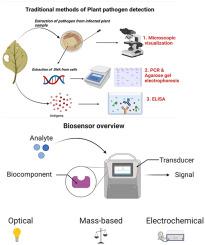Talanta ( IF 5.6 ) Pub Date : 2022-08-05 , DOI: 10.1016/j.talanta.2022.123808 Rhea Patel 1 , Bappa Mitra 2 , Madhuri Vinchurkar 3 , Andrea Adami 2 , Rajul Patkar 3 , Flavio Giacomozzi 2 , Leandro Lorenzelli 2 , Maryam Shojaei Baghini 3

|
There is an increasing demand for the development of various tools for diagnosis and control of plant infections. The early diagnosis of plant disease serves as a vital element to improve crop productivity and meet demands of the ever-growing world population. The traditional methods of plant disease detection are time consuming, laborious and require 3–5 days to estimate the disease incidence. In this review, we focus on the advances in the detection techniques, mainly the miniaturized systems that has developed in the last decade. The analytical techniques for plant pathogen detection have been classified as direct and indirect detection methods. The direct methods involving laboratory techniques such as polymerase chain reaction, enzyme-linked immune-sorbent assays, and immunofluorescence and their recent advances have been discussed. Similarly, indirect methods which rely on sensing the plant stress indicators to detect plant diseases have been categorized and reviewed. In the last decade, various detection platforms with high sensitivity and selectivity have been developed and commercialized into handheld devices and products for on-field plant disease detection. This review focusses on the transition from the gold standard techniques to the advanced on-field biosensors to detect plant diseases with higher accuracy, cost-effective and making timely diagnosis possible. A growing trend for pathogen detection based on biosensors has been highlighted and further categorized into electrochemical, optical, and mass-based sensors. These innovative advancements in plant pathogen detection systems help to make the agricultural sector more safe, reliable, and sustainable for the ever-growing population.
中文翻译:

植物致病性和相关/相关的检测系统。回顾
对开发用于诊断和控制植物感染的各种工具的需求日益增加。植物病害的早期诊断是提高作物产量和满足不断增长的世界人口需求的重要因素。传统的植物病害检测方法耗时、费力,需要 3-5 天才能估算病害发生率。在这篇综述中,我们关注检测技术的进步,主要是在过去十年中发展起来的小型化系统。植物病原体检测的分析技术分为直接检测方法和间接检测方法。已经讨论了涉及实验室技术的直接方法,例如聚合酶链反应、酶联免疫吸附测定和免疫荧光及其最新进展。相似地,对依靠传感植物胁迫指标来检测植物病害的间接方法进行了分类和回顾。在过去的十年中,各种具有高灵敏度和选择性的检测平台已被开发并商业化为用于现场植物病害检测的手持设备和产品。本综述侧重于从金标准技术到先进的现场生物传感器的转变,以更准确、经济高效地检测植物病害,并使及时诊断成为可能。基于生物传感器的病原体检测的增长趋势已被强调并进一步分为电化学、光学和基于质量的传感器。植物病原体检测系统的这些创新进步有助于使农业部门更加安全、可靠、











































 京公网安备 11010802027423号
京公网安备 11010802027423号